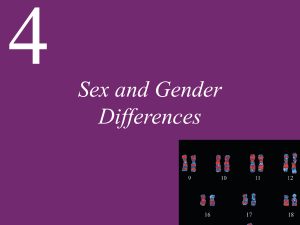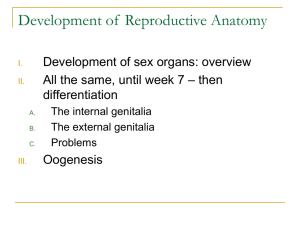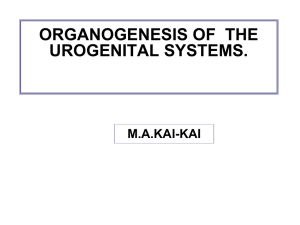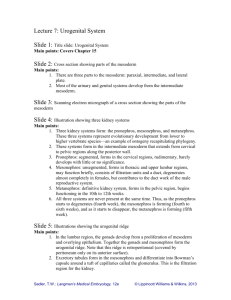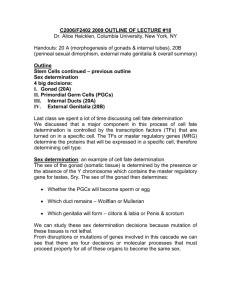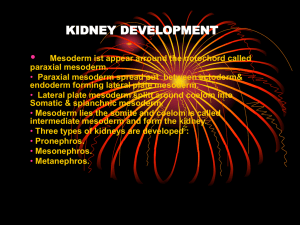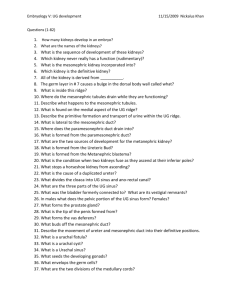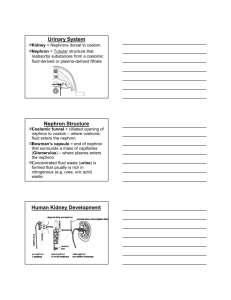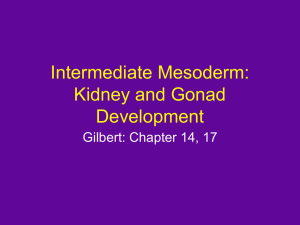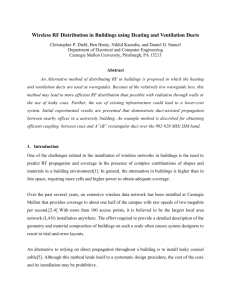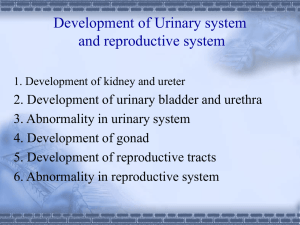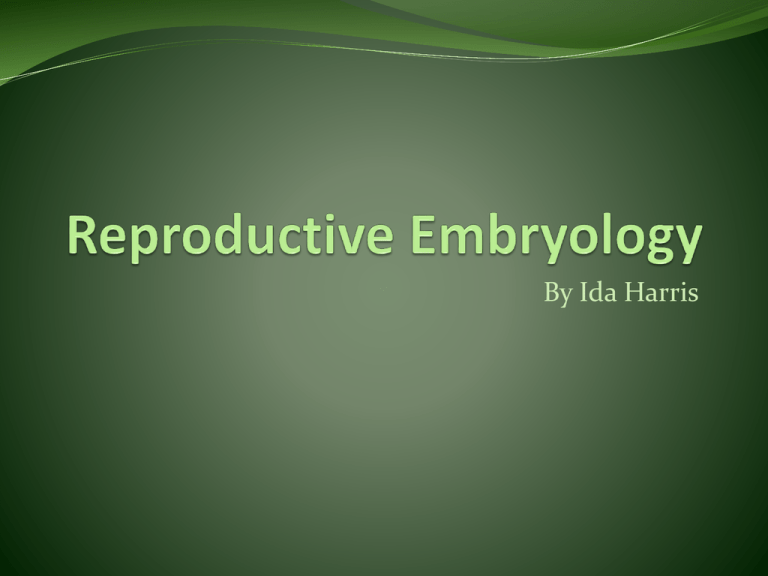
By Ida Harris
Summary:
Wk 5: primordial germ cells (from yolk sac) migrate into
singular, undifferentiated gonad (located at T10)
Wk 6: undifferentiated genitalia
in males, the medulla attaches to the mesonephric ductsTESTES
In females, the cortex attaches to the paramesonephric
ductsOVARY
In both sexes, the cloaca septates into the bladder and rectum
The metanephros (future kidney) buds from the mesonephric duct
Wk 7: both Mullerian and Wolffian ducts are present
Wk 10: Recognizable genitalia
Intermediate Mesoderm
Becomes the
suprarenal glands,
gonads, kidneys
and associated
tubes and
vasculature
Overview- Male
The male reproductive tract forms from Wolffian ducts
Seminal Vesicles
Epidydimis
Ejaculatory Duct
Ductus Deferens
Both the gonads and the Wolffian ducts form from intermediate
mesoderm
The Wolffian duct forms from the mesonephric duct(from
intermediate mesoderm), left over from the mesonephros (at wk 12).
Intermediate mesoderm also forms the gubernaculum, which pulls the
testes down into the scrotum
Overview: Male II
At wk 5, the gonads receive primordial germ cells from the yolk sac
At wk 6, the medulla of the undifferentiated gonad attaches to the
mesonephric ducts above the metanephros and becomes the testes.
This is induced by testosterone, stimulated by the SRY gene on the Y
chromosome.
Stimulates Sertoli cells to secrete Mullerian inhibiting factor
Stimulates the growth of the Wolffian ducts
By week 7, both mullerian and Wolffian ducts are still present, but
testosterone and MIF are actively produced
Descent of the testes is stalled at the inguinal ring until close to
delivery time
Overview: Male III
DHT (produced via 5-alpha reductase) induces
external male genitalia differentiation (penis, scrotum)
SRY, Sox9 (gonads), AMH/MIF(ducts) gene expression
5-alpha reductase deficiency: lack of DHT prevents
male differentiation until puberty (female external
genitalia changes to penis at puberty)
Overview: Male
nd
2
Sex Char.
Testicular Androgens
External genitalia development
Facial hair
Axillary and pubic hair
Enlargement of laryngeal cartilageand deepening of the voice
Increased muscle mass
GH (adenohypophysis)
Broadening of shoulders
Increased muscle mass
Estrogen
Growth spurt: estrogen receptors in bone
Overview-Female
The female reproductive tract forms from the Mullerian duct and
the gonads, which are both formed from intermediate mesoderm
The Mullerian duct does NOT form from the mesonephric duct,
rather it forms from the paramesonephric ducts into the
fallopian/uterine tubes.
The Mullerian ducts fuse at the caudal end to form the uterus
and top 1/3 of the vagina, remaining unfused at the other ends to
form the fallopian tubes which end near the gonads/ovaries.
Remnants also form the broad ligament, which suspends the
ovaries in the abdominal cavity
Overview: Female II
X chromosomes only
Stimulates Mullerian duct growth
Dax, Wnt4
Dax inhibits Sox9 (gonads), SRY expression in XXY
Overview: Female
nd
2
Sex Char.
Ovarian estrogen
Breast development
Genital development
Increased body fat and characteristic deposition
Growth spurt: estrogen receptors in bone
Progesterone (after menarche)
Breast development
Ovarian/Adrenal androgens
Axillary and pubic hair
GH (adenohypophysis)
Increased hip width
Kidney Development
Intermediate Mesoderm
Becomes the
suprarenal glands,
gonads, kidneys
and associated
tubes and
vasculature
Timeline
Day 18: intermediate mesoderm forms
Day 24:nephrogenic cord forms from intermediate mesoderm
Day 26:urogenital ridge (intermediate mesoderm) surrounds nephrogenic cords
Day 28+ (pronephros) forms from cranial nephrogenic cords
Day 28+ (wk4) to Day 84 (week12)(meSonephros) forms from middle nephrogenic cords
Day 42- (wk6)meTanephros forms from caudal mesonephric ducts
At this time, sexual differentiation is also occuring
Day 42 to 49 (wk6-7) cloaca(endoderm) separates to form rectum and bladder
Day 112 (wk 16) metanephros has lobes and function as the collecting ducts and ureter of
the final kidney. The metanephric blastema becomes the nephrons.
Timeline II-kidney
Wk 40
Conception
Pronephros, wk 4, degenerates after a few days, useless
Mesonephros (S for second) wk 4 to wk12,
connects to blood vessels at wk 6-7 to function
as rudimentary kidney
Metanephros (T for third), wk 6 onwards, buds out from
mesonephric duct, inducing the mesoderm around it
(metanephrogenic blastema) to become kidney renal
tubules (nephrons) while it becomes the ureter, renal
pelvis, calyxes and collecting duct system of the kidney.
Timeline III- with bladder
Wk 40
Conception
Pronephros(wk4)
Kidneys –intermediate mesoderm
Mesonephros wk 4 to wk12
Metanephros wk 6 onwards
Cloaca
(endoderm)
Hindgut separates into rectum (by wk7)
Bladder (by wk 7)
Third, final kidney, formed at week 6
Know the ‘Nephros
First, useless kidney, formed
and disintegrated at week 4
Part of mesonephros; the
second, transitory kidney
(wk4)
Joins with gonad medulla in
males to become the male
reproductive tract (wk6).
The migrations of kidneys/gonads
Kidneys go up/Gonads go down
Kidneys trade up for new arteries/Gonads take their arteries down with them.
Testes descend to the deep inguinal ring in week 12
At month 7-9, testes continue to descend into the scrotum
Adrenal/Epinephrine glands
Cortex forms from intermediate mesoderm of the
abdomen
Medulla forms from migratory neural crest
sympathetic ganglia
Chromaffin cells
Developmental Anomalies
Male Developmental Anomalies
Hypospadius: urethra opens on the underside/inferior side of the penis
instead of through the center of the glans.
Can be panscrotal, penile or in the glans.
Epispadius: urethra opens on the superior side of the penis instead of
through the glans.
Cryptoorchidism: Failure of the testes to descend into the scrotum
Associated with persistent Mullerian duct syndrome
Testicular hydrocele: fluid filled cysts in the scrotum
Indirect Inguinal Hernia
MDs don’t Lie (Indirect Inguinal hernias happen to infants and are
lateral to the inguinal ring) (medial:direct)
Female Developmental Anomalies
From not enough joining to too much:
Double uterus and vagina
Bicornate uterus
Double uterus
Septated uterus
Too much fusion of the
Not enough fusion of
If only
the Mullerian
one Mullerian
ductsduct is present
Mullerian ducts
NORMAL uterus
Other: unicornate uterus
Cervical atresia
External Genitalia
External Genitalia I
Genital tubercle
Male- glans penis and corpus cavernosum
Female- glans clitoris and clitoral crura and shaft
Urogenital Sinus
Male –, bulbourethral glands of Cowper, prostate gland
Female-, greater vestibular glands of Bartholin, urethral and Skene’s
(paraurethral) glands
Also forms the urethra, bladder and allantois
Urogenital Folds
Male- ventral shaft of penis, corpus spongiosum
Female-labia minora, vesticular bulbs
Labioscrotal Folds
Male-scrotum
Female-labia majora
Urogenital Fold
Becomes the ventral shaft of
penis (corpus spongiosum) in
males
Labioscrotal swelling
Genital Tubercle
Becomes the glans penis and corpus
cavernosum in males
Becomes
the glans
clitoris, crura
Cloacal
Membrane
and shaft of the clitoris in females
Becomes the labia minora and
vestibular bulbs in females
Primordial Phallus
Urogenital Fold
Indifferent State (male=female)
Urogenital membrane
Labioscrotal swelling
Becomes the scrotum in males
Becomes the labia majora in females
Anal Membrane
Male
Urogenital folds fuse to
become the corpus
spongiosum of the penile
shaft, the labioscrotal folds
fuse to become the scrotum.
The genital tubercle sticks
out at the end of the penis
as the glans penis. The rest
of the genital tubercle fuses
with the urogenital folds to
become the corpus
cavernosum.
Female
External Genitalia II
Male
Induced by DHT
Synthesis of DHT requires 5-alpha reductase
Female: lack of DHT
Summary:
Wk 5: primordial germ cells (from yolk sac) migrate into singular,
undifferentiated gonad
Wk 6: undifferentiated genitalia
in males, the medulla attaches to the mesonephric ductsTESTES
In females, the cortex attaches to the paramesonephric ductsOVARY
In both sexes, the cloaca septates into the bladder and rectum
The metanephros (future kidney) buds from the mesonephric duct
Wk 7: both Mullerian and Wolffian ducts are present
Y (SRY) chromosome induces testosterone
stimulates testes formation (making more testosterone/positive feedback)
Stimulates Sertoli cells to secrete Mullerian inhibiting factor
Stimulates the growth of the Wolffian ducts
X chromosomes only
Stimulates Mullerian duct growth
Wk 10: External Genitalia: DHT/5-aR for male differentiation (female default)
Quiz
Where do primordial germ cells come from?
Yolk sac
When do they invade the undifferentiated gonad?
Wk 5
What happens to the undifferentiated gonad in males?
Medulla joins with mesonephric duct
In females?
Cortex joins with paramesonephric duct
Quiz II
What forms from intermediate mesoderm?
Gonads, Wolffian/Mullerian ducts
Upper 1/3 of vagina, uterus, fallopian tubes,
ovaries, broad ligament
Testes, Seminal Vesicles, Epidydimis, Ejaculatory
Duct, Ductus Deferens, Gubernaculum
Basically everything except external genitalia
Adrenal glands, kidneys
Associated vasculature
Quiz III
What are the undifferentiated precursors of external genitalia? (and
the prostate which is internal)
Genital tubercle- glans penis/clitoris, crura and shaft of the clitoris,
corpus cavernosum of the penis
Urogenital Sinus- bulbourethral glands of Cowper, prostate gland in
the male, greater vestibular glands of Bartholin, urethral and Skene’s
(paraurethral) glands in the female. Also develops into the bladder,
urethra and allantois.
Urogenital Folds- ventral shaft of penis, corpus spongiosum ,labia
minora, vesticular bulbs
Labioscrotal folds- labia majora, scrotum
What do they become?
Quiz III
What genes cause male gonadal differentiation?
SRY, Sox9
What allow Wolffian duct proliferation?
Testosterone, MIF/AMH
What causes male external genitalia differentiation?
DHT, requiring 5-alpha reductase
What genes cause female gonadal differentiation?
Dax inhibits Sox9, absence of SRY
What causes female external genitalia differentiation?
Lack of DHT
Bibliography
Class Notes
Podcast
First Aid
Wikipedia


